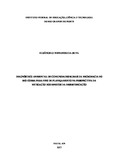Diagnóstico ambiental de comunidades rurais da microbacia do Rio Cobra para fins de planejamento na perspectiva da mitigação

Data
2017-05-11Autor
Silva, Elisângelo
040.082.684-48
http://lattes.cnpq.br/2355118201108577
Metadados
Mostrar registro completoResumo
This study had as general objective to elaborate the environmental diagnosis in rural communities, Currais Novos, Recanto e Zagarelhas, located in Cobra River Micro Basin, in the city of Jardim do Seridó, with planning purposes aiming to end the desertification effects, in the period from 2016 to 2017. The methodology is consisted by bibliographical review from books, thesis, periodic and documents; field research conduction for photographic registers; area mapping by satellite images; water sample collection for superficial and subterranean water quality evaluation, soil sample collection for fertility analysis; in loco observations, with the intent of identifying local fragilities and potential; interviews with the local residents in the communities and with businessmen in the potter sector. The result of this diagnosis identified that human activities developed on the three communities, allied to yearly drought periods contributed to vegetal cover reduction and seed bank destruction, leaving the soil exposed to erosive processes. Furthermore, human actions contributed to compaction and soil productive capacity loss, water sources sanding-up and superficial and subterranean water contamination, which has been causing a reduction in local population life quality, once these many residents are inserted in poverty line. Moreover, it was identified a high dependence of the families when it comes to rural retirements. However, the income obtained by the retirements has guaranteeing some financial base, even though, the traditional activities on the referred area such as agriculture, cattle breeding and pottery have been showing decline, due to rain shortage and natural resources decrease. Thus, new activities have been appearing in the communities like textile industry that employ a great number of people, mainly women that previously did not have job opportunities. The conclusion indicates the environmental diagnosis has fundamental importance and allowed to bring forth environmental, social and economic issues, on a small scale, making possible for managers and rural communities to provide an environmental planning, considering this new reality with the intention of guaranteeing the sustainable usage of natural resources and life quality improvements on the studied communities.



